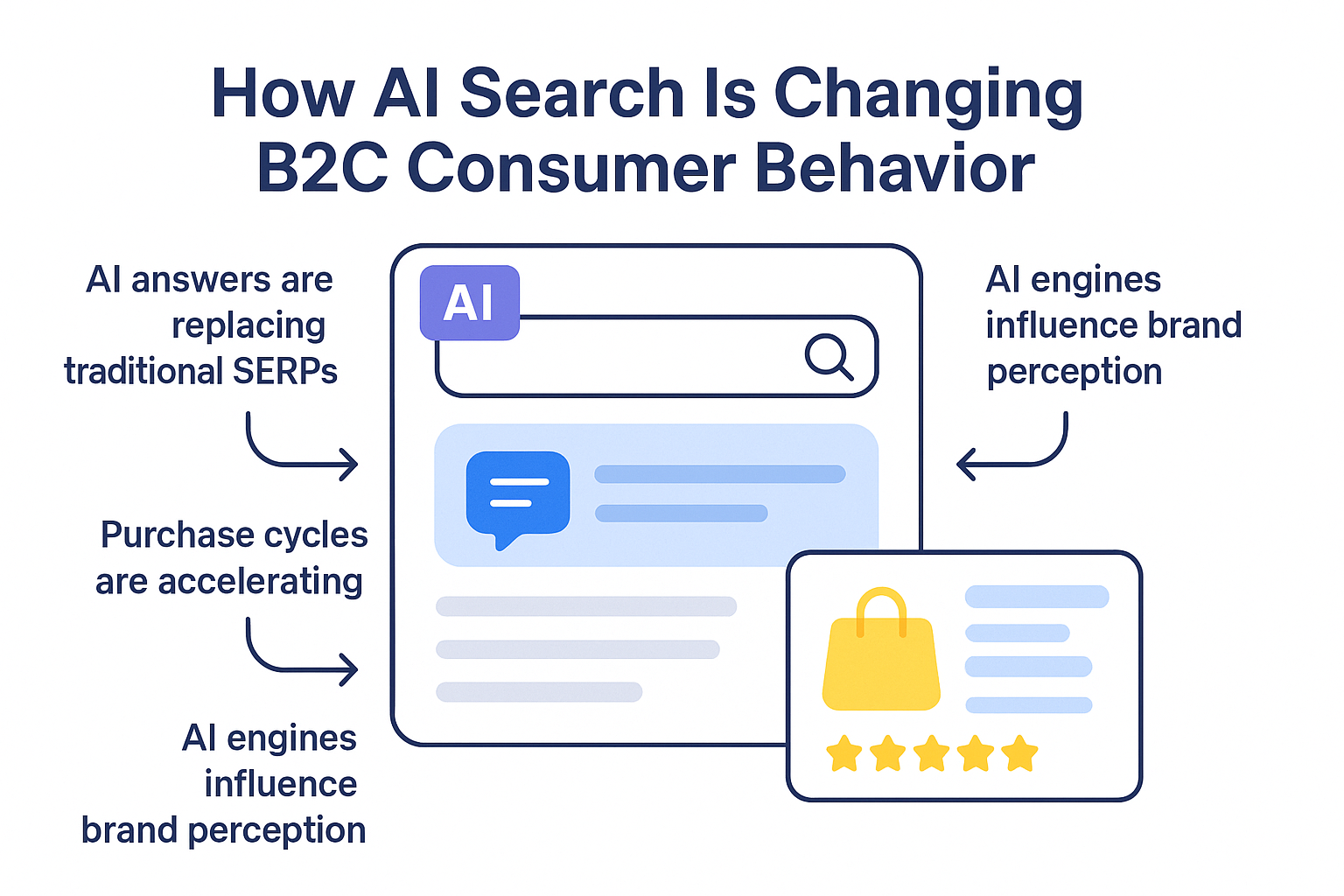November 21, 2025
Semantic Blocks: The New Structure of AI-Optimized Content
November 20, 2025
Multimodal SEO: How AI Uses Images, Video & Diagrams to Rank Pages
November 19, 2025
Author:
.png)
B2C search behavior has changed dramatically over the past few years.
Consumers no longer rely solely on Google to discover products — they move fluidly between social platforms, marketplaces, and AI-driven search engines. The journey is faster, more visual, and far more influenced by brand trust and social proof than by traditional keyword rankings.
AI search and social discovery have become primary entry points.
SearchGPT, Perplexity, and Bing Copilot provide instant product recommendations, summarize reviews, and compare brands without requiring users to click through to websites. At the same time, platforms like TikTok, Instagram, and YouTube act as search engines where consumers explore products through short-form videos, reviews, and UGC.
In this new environment, ranking is no longer just about showing up in Google.
Visibility must span all discovery surfaces — AI, social search, video search, and traditional SERPs.
“B2C SEO is no longer about traffic — it’s about influence across all discovery surfaces.”
Brands that adapt to this multi-surface discovery model dominate the modern consumer journey.
AI-driven search engines are reshaping how consumers evaluate products and make buying decisions.
Instead of scrolling through pages of links, users receive instant, structured recommendations.
AI systems analyze:
Consumers now get not just information — they get decisions.
Because AI search removes friction:
users can move from awareness → evaluation → purchase in a single query.
Example:
“Best vacuum cleaner for pets under $200.”
SearchGPT or Perplexity immediately provides:
This eliminates the multi-step research phase that traditional SEO relied on.
SearchGPT, Perplexity, and Bing Copilot have become new “trusted advisors.”
If AI consistently recommends a brand — consumers assume it’s reliable.
If AI ignores a brand — visibility and trust collapse, even if the brand ranks high on Google.
B2C SEO now requires optimizing for both search engines and answer engines, because AI-driven recommendations heavily impact consumer decisions long before they reach your website.

B2C discovery no longer happens in a single place.
Consumers now search across a blended ecosystem where Google, AI models, and social platforms all function as parallel search engines. To succeed in B2C SEO, a brand must be visible everywhere consumers look — not just in Google SERPs.
Google is still a primary discovery engine, but the experience has changed:
For many B2C categories, AI Overviews have become the first thing users see.
TikTok has become a real search engine for consumer products.
Users search for:
TikTok surfaces the most engaging short-form videos, making it a massive B2C discovery channel.
Consumers search within visual platforms:
YouTube especially influences BOFU decisions because long-form reviews and experiments feel trustworthy.
SearchGPT, Perplexity, and Bing Copilot answer:
These AI engines now act as advisors, guiding consumers before they ever reach Google.
Conclusion:
B2C search is now distributed across Google, AI, TikTok, Instagram, and YouTube.
Winning in 2025 means optimizing for all discovery surfaces — not just SERPs.
The ranking factors that drive B2C SEO performance in 2025 are very different from classic checklists.
Consumers expect trust, visual clarity, and quick decision support — and ranking systems reflect this.
Consumers buy brands they recognize and trust.
Search engines and AI models rank brands with strong:
Entity authority is now a core B2C ranking factor.
High-quality product pages win:
AI engines favor pages with structured, reliable information.
B2C ranking is heavily influenced by:
AI summarizers pull review sentiment directly into recommendations.
B2C products must win on visual surfaces:
If your product looks better visually, you win more clicks — even with lower ranking.
AI models prefer:
This makes your product more likely to be cited by SearchGPT or Perplexity.
Short, easy-to-share content performs best in social discovery:
These formats drive visibility on TikTok, Instagram, YouTube, and even inside AI chat engines.

B2C content must now support fast consumer decisions across multiple surfaces — Google, AI search engines, TikTok, Instagram, and YouTube. The classic funnel still exists, but content formats and expectations have evolved.
Users are exploring options, trends, and ideas.
Best formats:
The goal: make the brand recognizable, not force traffic.
Consumers want clarity, trust, and validation.
Key formats:
These formats are heavily favored by AI engines because they summarize real value.
Users already want to buy and need reassurance.
Best formats:
BOFU content improves both conversions and AI-driven recommendations.
In B2C SEO, short-form video is now equal to traditional content.
TikTok, Instagram Reels, and YouTube Shorts drive:
Short-form video is no longer optional — it is a ranking asset.

Product pages are now evaluated not only by Google but also by AI engines that extract, summarize, and cite content. To rank across both ecosystems, product pages must be clean, structured, and trustworthy.
AI engines rely heavily on structured markup:
Structured data increases both SERP visibility and AI citation probability.
AI models prefer pages with:
Visual clarity improves ranking in Google Shopping, YouTube, and TikTok recommendations.
Authentic reviews improve:
AI models increasingly use review sentiment to recommend or avoid products.
To get cited by AI engines like SearchGPT and Perplexity, product pages must include:
These elements make your product “machine-readable” and more likely to appear in AI answers.
Search behavior has shifted toward social platforms.
TikTok, Instagram, and YouTube now act as discovery engines — and their ranking mechanisms differ significantly from Google.
Platforms prioritize:
This means quality + consistency > keywords.
TikTok is now one of the top discovery engines for products.
Key ranking elements:
TikTok content often outranks Google for consumer decisions.
YouTube still dominates long-form product discovery:
Ranking factors:
YouTube influences BOFU decisions more than any other social platform.
Zero-click search is now a defining feature of B2C SEO.
As AI engines answer more queries directly, brands often see fewer website clicks but higher overall visibility. This is not a decline — it’s a shift in where the consumer journey happens.
Instead of chasing only traffic, brands must optimize for:
Even if users don’t click through, the brand can still win:
Zero-click discovery is still valuable — if you measure it correctly.
Track how often your brand appears:
Mentions = modern impressions.
AI systems pull sentiment and product attributes directly from user reviews.
More (and better) reviews = stronger AI recommendations.
If branded search volume rises, zero-click exposure is working.
People remember your brand and search directly later.
Many users discover products inside AI engines or social platforms and visit later via:
This is delayed attribution — but still generated by zero-click visibility.
Traditional KPIs like “organic sessions” are no longer enough.
B2C SEO requires tracking influence, not just clicks.
How often AI engines cite or recommend your brand.
This is now one of the strongest predictors of B2C visibility.
Not just page ranking — but:
The modern SERP is visual and multi-layered.
Percentage of image/video placements your brand controls for key queries.
For B2C, visual presence often converts better than blue links.
AI engines heavily weight sentiment.
Positive + recent reviews improve ranking, trust, and AI recommendations.
If branded search volume increases, your influence is growing — even without clicks.
TikTok, Instagram, and YouTube impressions indicate early-funnel dominance.
These platforms shape preferences before users ever reach Google.
The evolution of B2C SEO is accelerating, and AI is at the center of it.
Consumers increasingly shop through AI recommendations.
AI becomes the new product advisor.
Recommendations will adapt based on:
Every user sees a different “SERP.”
Instead of optimizing for search engines alone, brands optimize for networks:
This is the next stage of SEO evolution.
Voice queries (“what’s the best…”) feed directly into AI engines.
Products optimized for conversational search will dominate early adopters.
Your new AI assistant will handle monitoring, audits, and reports. Free up your team for strategy, not for manually digging through GA4 and GSC. Let us show you how to give your specialists 10+ hours back every week.
Read More

November 21, 2025
10 min

November 20, 2025
10 min

November 19, 2025
10 min
Just write your commands, and AI agents will do the work for you.